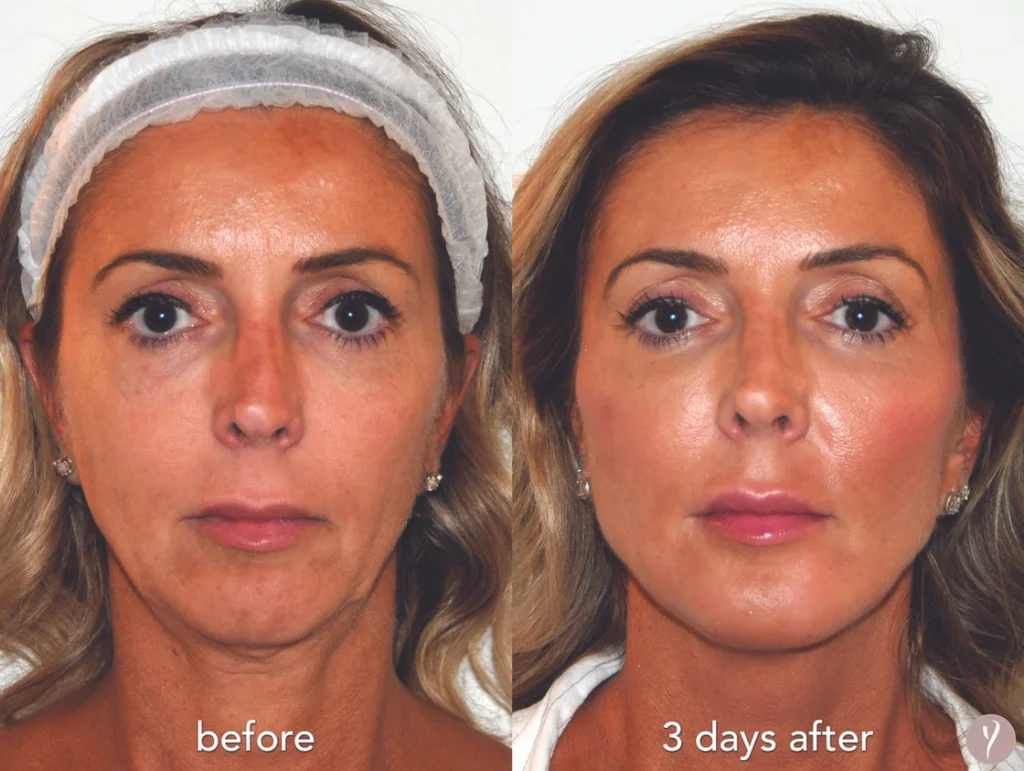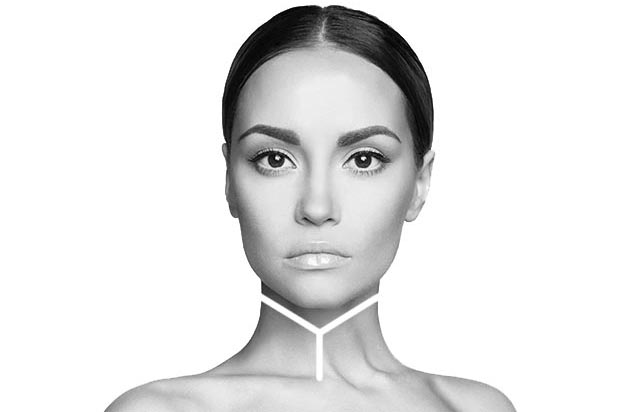
Combining V-Line Surgery and Barbie Line Rhinoplasty
7 mai 2025
Rides et plis du cou : Radiofréquence + microneedling+ Polynucléotides
19 mai 2025Y-Line Facial Surgery : Everything You Need to Know
In the world of plastic surgery, particularly in South Korea where procedures like L-line rhinoplasty are popular, the « Y-line » has emerged as a coveted aesthetic ideal. The term « Y-line » refers to a facial profile that creates a smooth, V-shaped contour from the cheeks down to the chin, resembling the letter « Y » when viewed from the front.
This look emphasizes slenderness, youthfulness, and facial harmony, contrasting with broader or more square jawlines. It’s heavily influenced by Korean beauty standards, where a small, oval or V-shaped face is associated with femininity, elegance, and attractiveness—often amplified by K-pop culture and social media.
While you mentioned « Y-Lift, » which might be a confusion with the non-surgical Y-Lift procedure (a filler-based treatment), I’ll focus here on surgical options to achieve a Y-line. These typically include procedures like mandibular angle reduction, zygomatic (cheekbone) reduction, and sometimes genioplasty (chin reshaping). Unlike the non-surgical Y-Lift, which uses injectable fillers for temporary lifting, Y-line surgery is invasive and aims for permanent results.
Y-line surgery is part of the broader category of facial contouring, which has seen a surge in popularity since the 2000s in Asia. According to the International Society of Aesthetic Plastic Surgery (ISAPS), South Korea performs a disproportionate number of facial surgeries per capita, with procedures like these making up a significant portion. The goal is to enhance facial proportions, reduce perceived masculinity in the jawline, and create a more balanced, aesthetically pleasing face. However, it’s essential to approach this with realistic expectations, as surgery involves risks and isn’t a one-size-fits-all solution.
In essence, Y-line surgery transforms a wider or more angular face into a tapered, youthful shape. It’s often combined with other procedures, such as rhinoplasty (as in our earlier discussion), for a holistic facial makeover. This surgery isn’t just about vanity; for many, it’s a path to increased confidence and alignment with personal or cultural ideals of beauty.
The Y-Lift, known as the 30-minute miracle facelift, is a minimally invasive facial contouring procedure. It enhances the cheekbones, revitalizes the under-eye area, defines the jawline, and lifts the upper neck for a more youthful appearance.
Y-Lift, Y-Line : The Procedure Step-by-Step
Y-line facial surgery encompasses several techniques, depending on the patient’s anatomy and goals. It’s typically performed under general anesthesia in a certified surgical facility, and the process can take 2-5 hours. Here’s a detailed breakdown:
- Pre-Operative Preparation:
Before surgery, patients undergo a thorough consultation, including 3D imaging and facial analysis. Surgeons assess bone structure, skin elasticity, and overall health to customize the plan. Blood tests, X-rays, and sometimes CT scans are standard to evaluate the jaw and cheekbones. Patients are advised to stop smoking, avoid certain medications (like blood thinners), and maintain a stable weight, as fluctuations can affect results. - Surgical Techniques:
- Mandibular Angle Reduction: This is the core of Y-line surgery. The surgeon makes incisions inside the mouth (to avoid visible scars) and removes or shaves down the angle of the mandible (jawbone). This reduces a square jaw to a softer, more tapered shape. In some cases, a burr or saw is used for precise bone contouring.
- Zygomatic Reduction: For a fuller Y-line, the cheekbones may be reduced. This involves fracturing and repositioning the zygomatic bone through incisions in the mouth or hairline. The goal is to narrow the mid-face, creating a smoother transition to the jaw.
- Genioplasty (Chin Reshaping): If the chin is recessed or prominent, it’s reshaped using implants or bone adjustment. This ensures the « Y » shape is symmetrical and balanced.
- Additional Enhancements: Fat grafting or Botox might be incorporated to add volume to the cheeks or soften muscles, enhancing the overall contour.
The surgery is often performed as an « open » procedure, meaning incisions are made to access the bones directly. In advanced cases, endoscopic tools minimize trauma. Surgeons use dissolvable plates and screws to secure bones, promoting healing.
- Anesthesia and Intra-Operative Care:
General anesthesia ensures comfort, with monitoring of vital signs throughout. The surgical team focuses on precision to avoid nerve damage, which could lead to temporary facial numbness. - Post-Operative Immediate Care:
After surgery, patients are moved to a recovery room and monitored for swelling and bleeding. Drains might be placed to remove excess fluid, and a compression garment is worn to reduce edema.
This procedure requires a skilled surgeon, often board-certified by the Korean Society of Plastic and Reconstructive Surgeons (KSPRS). In South Korea, clinics in areas like Gangnam offer state-of-the-art facilities, with surgeons specializing in ethnic facial contouring.
Candidacy for Y-Line Surgery
Not everyone is a suitable candidate for Y-line surgery. Ideal candidates are typically adults in good physical and mental health, with realistic expectations. Here’s who might benefit:
- Physical Factors: Individuals with a square or wide jawline, often due to genetics or muscle hypertrophy (e.g., from teeth grinding), are prime candidates. It’s popular among those of Asian descent, where a rounder face is common, but anyone seeking a V-shaped contour can pursue it. Age-wise, patients should be at least 18-20 years old, once facial growth is complete.
- Psychological and Lifestyle Factors: Candidates should have a positive body image and understand that surgery enhances, not perfects, appearance. Those motivated by personal confidence rather than external pressures (e.g., social media) fare better. Non-smokers with no history of keloid scarring or bleeding disorders are preferred, as these can complicate healing.
- Contraindications: People with conditions like temporomandibular joint (TMJ) disorders, severe dental issues, or uncontrolled diabetes may not qualify. If you have thin skin or poor bone density, risks increase. Surgeons also screen for body dysmorphic disorder, as cosmetic surgery isn’t a mental health solution.
In South Korea, where this procedure is routine, consultations include psychological evaluations. For international patients, language barriers might necessitate translators.
Benefits and Risks of Y-Line Surgery
Benefits:
- Aesthetic Improvements: Achieves a slimmer, more feminine face, boosting self-esteem and aligning with beauty ideals.
- Long-Lasting Results: Unlike fillers, surgery offers permanent changes, with results visible after swelling subsides (typically 3-6 months).
- Complementary to Other Procedures: Pairs well with L-line rhinoplasty for full facial harmony.
- High Satisfaction Rates: Studies from the Korean Journal of Plastic Surgery report over 80% patient satisfaction when performed by experienced surgeons.
Risks:
- Common Complications: Swelling, bruising, and numbness can last weeks. Infection or hematoma (blood collection) occurs in 1-5% of cases.
- Serious Risks: Nerve damage might cause asymmetric smiling or sensation loss (rare, <1%). Bone irregularities or over-resection can lead to an unnatural appearance, requiring revisions.
- Long-Term Issues: Changes in bite or TMJ problems may arise. As with any surgery, there’s a risk of anesthesia reactions or scarring.
- Psychological Risks: Some experience regret if results don’t meet expectations.
Mitigating risks involves choosing accredited clinics and following post-op care diligently.

Recovery Process Y-Lift Surgery
Recovery from Y-line surgery takes 4-6 weeks, with full results in 6-12 months. Initially, expect swelling and discomfort, managed with pain medication and ice packs. A liquid diet is recommended for the first week to avoid jaw strain, gradually progressing to soft foods.
Patients should avoid strenuous activities, smoking, and direct sun exposure. Follow-up appointments monitor healing, with sutures dissolving in 1-2 weeks. Swelling peaks at 48-72 hours and subsides gradually. Most return to work in 1-2 weeks, but high-contact jobs may require longer.
Y-Line Facial Surgery : Costs and Global Perspectives
In South Korea, Y-line surgery costs 3,000,000-8,000,000 KRW ($2,300-$6,000 USD), depending on complexity and clinic. Factors like surgeon expertise and location (e.g., Seoul) influence pricing. International patients add travel costs (e.g., $1,000+ for flights and accommodation).
Globally, similar procedures in the US or Europe cost $5,000-$15,000 USD. Always verify with clinics, as packages may include aftercare.
Final Thoughts and Recommendations
Y-line facial surgery can transform your appearance, but it’s a significant decision. Weigh the benefits against risks, and prioritize board-certified surgeons. If you meant the non-surgical Y-Lift, that’s a quicker, cheaper option (around $2,000-$4,000 USD per session). For more details or to clarify, feel free to ask. Remember, this overview is informational—seek professional advice for your specific case.


